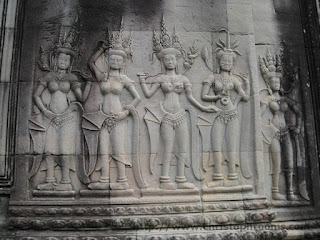aerial view of Angkor Wat
totally surrounded by wall
When the Khmer Empire came to power, Hinduism became the official religion. Angkor in Northern Cambodia was the capital of the Khmer Empire and thrived from the C9th on, marking the apex of its architecture. Angkor stretched over 400km², home to a number of temples: Angkor Wat, Angkor Thom, Bayon Temple and Ta Prohm. Angkor Wat was a temple complex with 1000+ buildings, one of the great cultural wonders anywhere.
One of the 5 central towers
Because the temple complex was built in the Khmer Empire capital, all of the original religious motifs were derived from Hinduism, and were dedicated to the gods Shiva, Brahma and Vishnu. Note that Angkor Wat faced west, dedicated to the Hindu god Vishnu.
Angkor served as the royal centre from which the Khmer dynasty ruled one of the largest, most prosperous and most sophisticated kingdoms in S.E Asia. Many building projects were undertaken, built by
King Suryavarman II (r1113–c1150) as a vast memorial temple in which his remains would be placed. Shortly after he took the throne in 1113, construction of the Angkor Wat complex took c3 decades. Royal succession in the Khmer empire was often a violent affair; Suryavarman killed his great-uncle in battle to seize the throne. But apparently he created stability. He continued the tradition of the previous kings, building a new royal temple complex, but did not design the temple’s design. Probably his chief priest did.
The 5 central towers of Angkor Wat symbolised the 5 peaks of Mt Meru, which the Hindu faith saw as the dwelling place of the gods. The 15’ high walls signified the surrounding mountain ranges and the moat represented the sea, both structures protecting the complex. A 188-metre bridge allowed access to the site, then visitors reached the temple by passing through 3 galleries, each separated by a paved path.
To further emphasise the Hindu symbolism, the temple walls were lined with c2,000 square ms of beautiful bas-relief sculpture carved into the sandstone. Plus there were extensively carved lintels, friezes and pediments, 2,000 celestial dancers entertaining the gods on the walls, and depictions of the Angkorian king and his court. Most sculptures depicted the Hindu epics Ramayana and Mahabharata.
Examine the architecture. A wide rectangular moat surrounded the complex, and just inside the moat an outer wall defined an area c1,500 ms E-W, and 1,300 ms N-S. Some archaeologists suggested that 90% of this area was originally surrounded by a city around the formal temple precinct, including the royal palace, all built of wood. Only the temple’s interior structures, built in sandstone and laterite
clay, remain today.
celestial dancers on the middle terrace
yatrikaone
Angkor Wat statues
Westend61
From the western gateway of the outer wall, a long causeway led to the main temple precinct. Two small stone buildings, called libraries/ shrines, flanked the causeway near the midpoint.
The temple itself consisted of the primary elements of Khmer architecture: 1] pyramids and 2] concentric galleries. Each pyramid took the form of 3 stepped terraces, with the steps bordered on all sides by covered galleries. At each level gateways in the galleries indicated the pathway to the central shrine, and towers punctuated the corners. The pyramid culminated in 5 towers, marking the central shrine.
The whole complex symbolised the Hindu beliefs enshrined within, a microcosm of the Hindu universe. The moat represented the mythical oceans surrounding the earth and the succession of concentric galleries represent the mountain ranges that surround Mt Meru. The towers represented the mountain’s peaks, and the experience of the ascent to the central shrine seemed like climbing a real mountain. Dedication to the Hindu god Vishnu only ended in the C13th.
After the Cham people sacked Angkor in 1177, King Jayavarman VII (reigned 1181–c1220) decided that the Hindu gods had deserted him. When he built a new capital nearby, Angkor Thom, he dedicated it to Buddhism. Thereafter Angkor Wat became a Buddhist shrine, and many of its carvings and statues of Hindu deities were replaced by Buddhist art. Note that Buddhist tolerance for Hinduism meant that the iconography of its great reliefs was not totally replaced; some of the intricate sandstone bas-relief sculptures were still showing Khmer artistry.
In the decades after Suryavarman II’s death and his cousin’s dismal reign, King Jayavarman VII converted many of the temples to Buddhist use. The temples at Angkor were often depicted as the ruins of a failed society, but actually the rise of Theravada Buddhism led to the construction of wooden temples that didn’t survive. Angkor Wat had represented the best building tradition over 5 centuries. In the early C15th Angkor DID come to a standstill, yet Buddhist monks maintained Angkor Wat for pilgrims.
One of the first modern Western visitors was a Portuguese friar who visited in 1586. Angkor Wat was later “re-discovered” by the French naturalist Henri Mouhot in the 1840s. Mouhot’s notes, published in 1863, aroused Western interest in Angkor and the Ecole Francaise d’ Extreme-Orient began leading conservation efforts.
map of Cambodia
Siem Reap-Angkor Wat marked in blue
The Cambodian flag
The French, who ruled Cambodia for much of the C20th, restored the site for tourism purposes. Cambodia won independence from France in 1953 and has controlled Angkor Wat ever since. However restoration work was later disrupted by the
Cambodian Civil War (1967-75) and the rule of the
Khmer Rouge in 1975-79. Angkor Wat avoided destruction, but bullet holes on its outer walls remained from the Khmer Rouge regime. Angkor became a
UNESCO World Heritage Site in 1992 and
was immediately added to the list of World Heritage in Danger. Preservation work continues. It is now a very popular attraction for 2 million tourists yearly.
Today the blue and red national flag depicts the main building of Angkor Wat, the ancient temple complex.




















